Optimize SAP AP workflows with automation
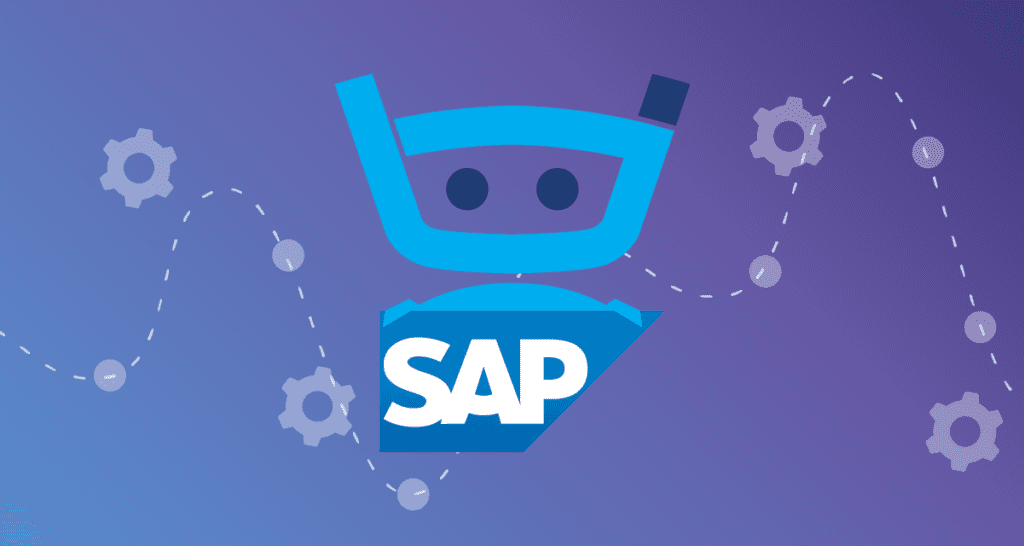
SAP customers can get the most out of their accounts payable (AP) processes by automating and optimizing key workflows. To fully optimize SAP business systems for AP, you need a comprehensive accounts payable solution that streamlines invoice processing and expense reporting workflows and seamlessly integrates with SAP to share data with all stakeholders.
Read on to learn how integrated AP process automation can empower SAP S/4HANA or ECC customers to reduce costs, improve master data completeness and transparency, simplify collaboration, and make accounts payable a strategic driver for your business.
Accounts payable process automation is the right strategy
Accounts payable is evolving from a traditional back office function into a strategic business driver. CFOs face increasing pressure to optimize accounts payable processes, with sometimes conflicting priorities. For example, AP departments face pressure to reduce costs; however, the volume and complexity of invoices also grow as businesses grow.
Invoice processing and expense management are the two core accounts payable workflows. They are typically manual, error-prone, and highly inefficient, especially for businesses using paper documents and email to manage document flow and communications. Although powerful ERPs like SAP can automate and streamline financial workflows, they are also complex. They can be cumbersome for AP teams if they’re not specifically designed to optimize accounts payable processes or lack automation features.
Manual AP processes hold back your business
Many companies use manual accounts payable processes for data entry, invoice processing, expense reporting, verifying and approving expenditures, and making payments. Although most companies use digital systems to automate workflows, these systems are still considered manual if they don’t facilitate easy and fast invoice and expense processing. As a result, AP processes are often slow, prone to errors, and don’t scale easily to support business growth.
Poor-quality data leads to poor-quality decisions
CFOs need accurate and timely data to support business decisions, implement internal controls, and detect fraud and errors. It can be hard to make the right decision when you don’t have all the necessary information. Manual processes are inefficient, produce low-quality transaction data, and are not transparent.
ERPs also have a distinct organizational structure that can lead to information silos. Structuring menus and workflows and controlling access by role makes sense from a high-level category standpoint. However, it can restrict efficient accounts payable processing. For example, role-based permissions can cut off AP teams from the people and information required to process invoices and expense reports. Moreover, businesses often opt to restrict the number of seats available in an enterprise ERP system to reduce expenditures, as providing access to the entire organization can be costly.
To meet these challenges, CFOs need an AP automation solution to optimize existing workflows and provide the data transparency and control finance teams need to make informed strategic decisions. The ideal AP system automates invoice processing and expense management while seamlessly sharing transaction data and communications with ERPs and accounting systems.
Let’s examine how to use AP automation and SAP ERP systems to optimize the two core AP functions: invoice processing and expense management.
Optimize invoice processing with automated workflows
Invoice processing is a core AP function and part of the procure-to-pay workflow in SAP. For most businesses, invoice processing begins when a vendor invoice is received and ends when the finance team sends the payment to the supplier.
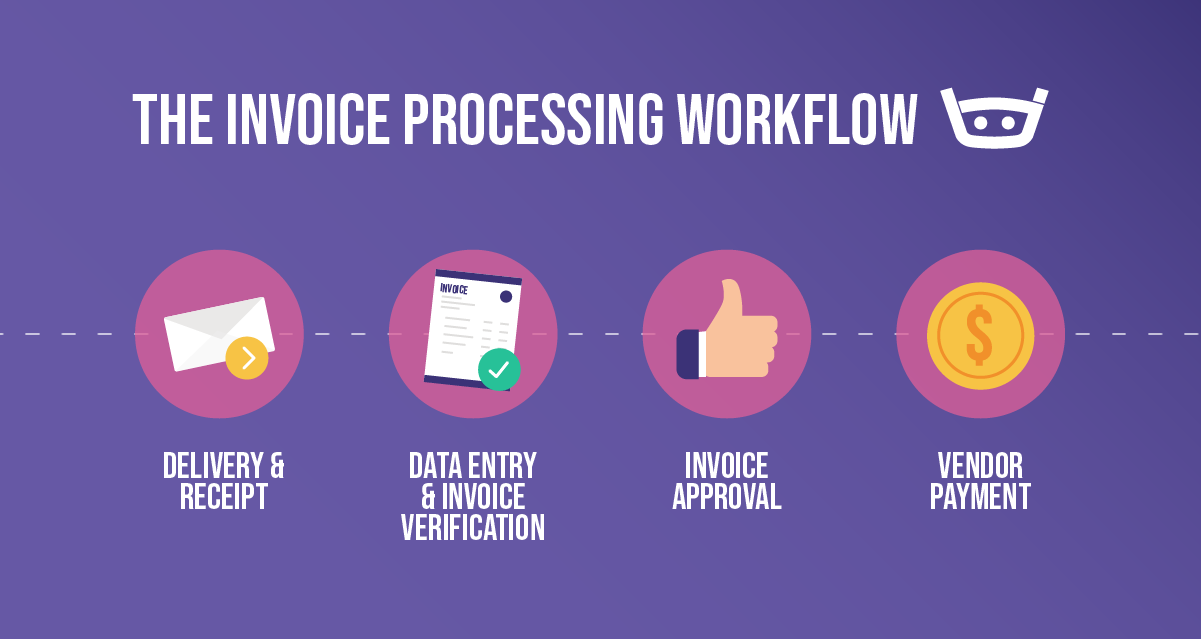
Businesses may integrate the invoice workflow with the procurement process in their ERP environment to take advantage of the platform’s power and customizability. However, using your ERP’s built-in AP solutions can be challenging for finance teams. For example, some platforms distinguish between invoices backed by purchase orders and those not, resulting in users needing to switch screens for processing.
Customers cite SAP’s complexity and steep learning curve. For example, one reviewer mentioned, “One drawback of SAP S/4HANA Cloud is the potential complexity and cost involved in its implementation and customization. As a powerful and feature-rich ERP system, it requires thorough planning, skilled resources, and significant time investment to deploy and configure according to the organization’s unique requirements.”
In a moment, we’ll contrast SAP’s complexity and steep learning curve to Stampli’s simplicity and ease-of-use. But first, here are the main steps of the invoice processing workflow and strategies on optimizing them with an integrated accounts payable automation solution for SAP, designed to align seamlessly with an organization’s unique requirements.
Invoice workflow step 1: Delivery and receipt
The invoice workflow begins when the supplier delivers the goods or services. The buyer inspects the delivery to confirm the order is complete, and then the vendor receipt is approved or rejected back to the supplier.
Delivery and receipt optimization with AP automation
Paper receipts can be misplaced or destroyed, which delays the invoice process and makes verifying purchase orders and invoices challenging. AP automation platforms can either have documents sent directly to the system or scanned in. The AP documents are securely organized and stored in a central location, where employees can easily access them for verification later.
Enhanced document management with Stampli
Stampli uses machine learning to capture transaction data from paper or email receipts and sync them with SAP in real time. Vendors can also send email receipts to a central email or upload them through Stampli’s Advanced Vendor Management portal to reduce paperwork and ensure receipts aren’t lost.
Onboarding a vendor in SAP is notoriously complex. Onboarding a vendor in Stampli is far simpler, but just as comprehensive. “We are in the process of really taking advantage of the vendor management,” commented a user. “Being able to onboard a vendor straight from Stampli and getting updated forms on file by automatic reminders from Stampli to the vendor, is going to be a huge time saver!”
Invoice workflow step 2: Data entry and invoice verification
The data entry and invoice verification step begins when the vendor sends the invoice. When it arrives, the AP team keys the invoice into their accounting system, applies GL codes, and performs two- or three-way matching against the purchase order and receipt to confirm that the invoice information is valid. If the invoice matches, the AP team forwards it for approval and payment.
How automation expedites invoice processing
AP automation software optimizes invoice processing and matching by replacing manual scanning, coding, and matching with an automated data capture process. Here’s how:
- First, the system automatically scans, enters, and codes paper or email invoices and syncs the invoice data with SAP.
- Next, the system performs two or three-way matching against digital copies of the purchase order and receipt.
- If there is a discrepancy, the system flags the error and alerts the AP staff. If the invoice is accurate, the system forwards it for approval and alerts the approver that it is ready.
Some ERPs require a two-screen approach to two and three-way matching. That means that users must navigate multiple sub-tabs and manage multiple documents to verify invoices accurately. This can slow down invoice processing and cause late or missed payments (and frustrate vendors.)
Next-generation invoice processing with Stampli
Customers say while SAP represents the old tried and true method of invoice processing, Stampli represents a leap forward for invoice processing: Stampli’s “digital invoice and supporting documents feature is a major improvement.” One Stampli user commented on how Stampli helped them eliminate paper processes: “We used to go to filing cabinet, pull documents, scan them, and put them back. Now I can just follow a link directly to the invoice. Amazing!”
Stampli lets AP teams enter and code invoices faster. It supports all line types, including GL, charges, fixed asset lines, and resources, and automatically syncs tax data and custom fields with SAP. Stampli can also manage partial payment workflows and multiple POs or receipts and supports multiple locations, subsidiaries, and currencies.
With SAP, two- and three-way PO matching requires multiple screens and chasing stakeholders for documentation. With Stampli, two- and three-way PO matching happens on one screen, with easy access to stakeholder documentation. As a user mentioned, “My location just recently implemented SAP and we just recently started using the SAP version of Stampli. It’s making it much easier to reconcile Purchase Orders for payment.”
Invoice workflow step 3: Invoice approval
After being processed and verified for accuracy, the invoice is sent for approval. The approval package in companies using manual processes is usually a paper file or email delivered to the approver. The approver reviews the invoice and transaction information and either approves it for payment or rejects it and sends it for further review.
How AP automation improves invoice approvals
With manual approval processes and complex ERP organization structures, documents are lost or misdirected, emails get buried, information is blocked in silos, and approvers are busy getting business done in their departments, which can lead to forgotten or delayed approvals on expenditures. AP automation improves the approval workflow by sending the approval request with all the required information attached and reminding the approver regularly if they don’t approve or reject the request. Once the invoice is approved, the system forwards it to the ERP or accounting system for payment.
Painless invoice approvals with Stampli
Customers say Stampli makes invoice approvals for SAP easy. When AP sends an invoice for approval in Stampli, the approver can review the request, communications, and supporting information in the Stampli dashboard. Stampli also supports approval workflows for partial payments and multiple approvers. Once an invoice is approved, Stampli creates a vendor bill in SAP and synchronizes the transaction data and communications across both systems.
SAP makes accountability and context difficult because information is so scattered. Stampli ensures accountability and context by putting the invoice information in one place. “No more relying on just one person to approve all the invoices,” remarked one user on G2. “Stampli allows you to set up different departments so you can have approvers from any area of the business weigh in on invoices and charges for the company…Need more than one person, easy enough. Just add as many names as needed to the approval list.”
Invoice workflow step 4: Vendor payment
After the invoice is approved, AP refers it for payment. Payments are made according to the contract terms with the supplier and may be by check, ACH, corporate card, or another electronic payment method.
How AP automation makes vendor payments easier
Many companies use digital payment methods. Digital payments are faster and less prone to errors than traditional payment methods. In addition, digital payment platforms offer more control and flexibility over the payment process. AP automation software can centralize payment methods onto a single platform, seamlessly sync payment data with SAP, and ensure that the finance department has up-to-date payment terms, bank account information, vendor payment details, credits, and discounts. In addition, AP automation software solutions like Stampli are flexible, with payment methods either in or outside the AP system.
Control payments with Stampli Direct Pay & Stampli Card
Stampli Card and Stampli Direct Pay give you complete control and transparency over the payment process and card spending. Purchases made with Stampli Card are automatically synced in SAP as a payment receipt. Your finance department can monitor and control all card transactions, statements, and invoices in one location. Customers say Stampli Card is “a game changer for processing credit card purchasing…with the right eyes on the right bills, questions have been asked and errors have been caught. We have saved more money then ever. Double payments have also gone down.”
Each payment approval is based on your predefined approval process, so you can ensure the right approvals are in place before you make payment. Payments to suppliers are made instantly through Stampli Card or by check or ACH.
Want to know more about how Stampli integrates with SAP to optimize invoice processing workflows? In Stampli Connects: Transform Your AP Processes with SAP & Stampli, our ERP experts will walk you through the details.
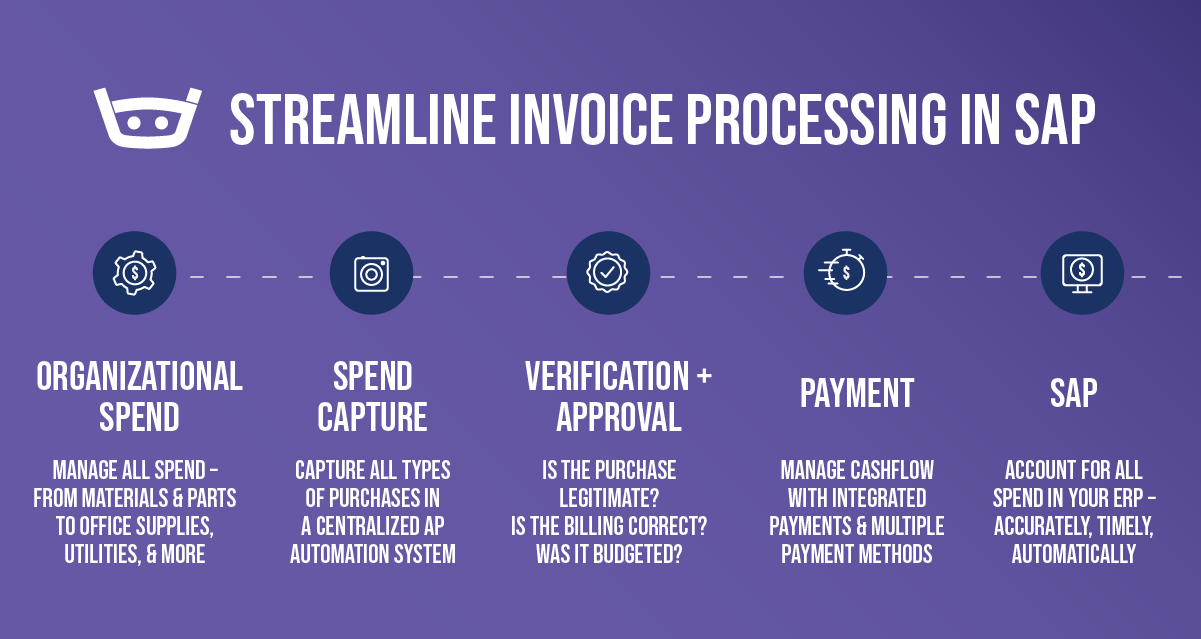
Streamlining expense management workflows
AP teams need an efficient process to manage employee expenses. Many businesses still rely on manual workflows for these tasks:
- Collect receipts
- Assign expenses to GL accounts
- Pay corporate credit card bills
- Time-intensive employee reimbursements through payroll
- Post expense reports and data to the SAP ERP
Here’s how AP automation can streamline the expense management workflow and save your business time and money:
Expense workflow step 1: Submitting receipts
Each employee keeps physical receipts of their purchases and expenses and uses a spreadsheet template to post the expense date, amount, category, and other information. The employee scans the receipts and then emails them and a copy of the spreadsheet to the AP department for approval. The AP team often needs to follow up with the employee by email or phone to clarify expenses.
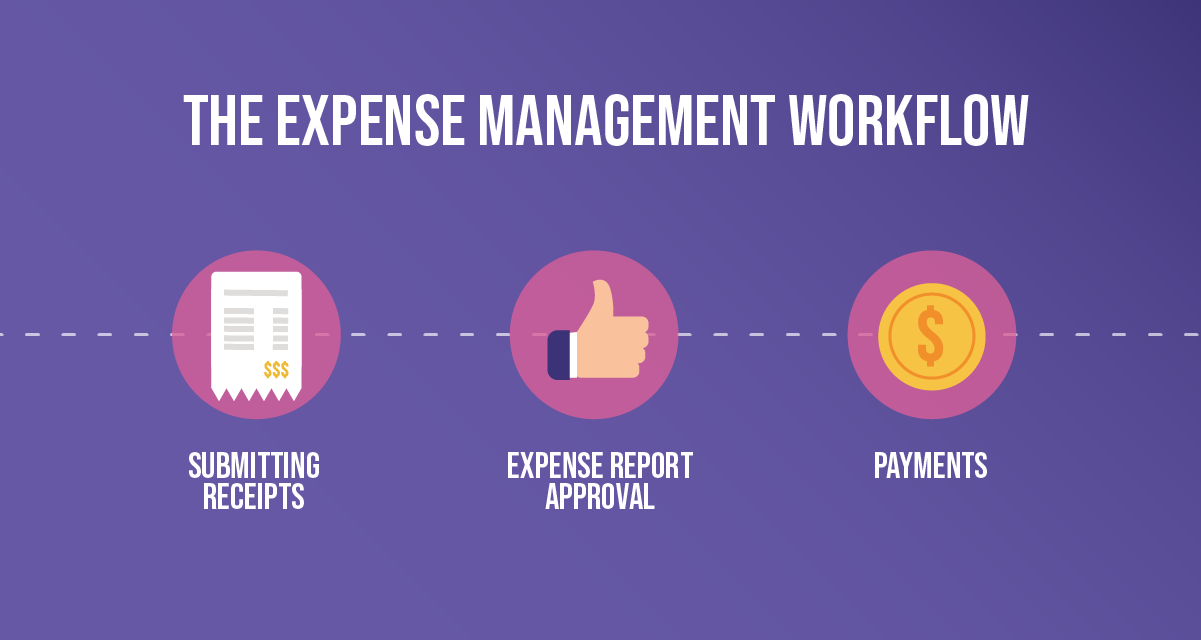
How AP automation improves expense reporting
With an AP automation platform, employees can immediately scan and upload their receipts into a personal receipt library and then match the receipt to an expense later. This process prevents receipts from being lost or destroyed while the employee travels. It also removes time-consuming expense reports that require effort from the employee and the AP team.
Expedited expense reporting with Stampli Card
Stampli provides a unified, filterable view for all expense types. Users can also easily create reports for expenses if needed. You can seamlessly share GL accounts, expense information, departments, locations, and custom fields between Stampli and SAP.
While customers lament the complexity of SAP for processing expenses, customers cheer Stampli as “Super easy and simple to use” for processing expenses and that “The upside of using Stampli is their ability to trackdown all expenses in one place and how easy it is to upload receipts.”
With Stampli Card, employees can easily capture and upload receipts with minimal paperwork or lost receipts, and the AP staff can review Stampli Card purchases instantly. Stampli Card captures and stores expense data each time employees make a purchase, giving AP real-time visibility into expenses. It gives employees the flexibility of a corporate card while AP teams still have the control over employee spend that they need.
Expense workflow step 2: Expense report approvals
Once the employee submits the expense report to AP, the AP team emails the report and documentation to the proper approver. If the company expense policy does not permit the expense or the expense report doesn’t contain receipts or supporting documents, the approver emails the AP department, and the expense is held until the exception is resolved.
When the approver approves the expense, AP codes the expense to the appropriate expense accounts and files the documentation. If the employee incurs expenses on a corporate credit card, AP waits until the card statement arrives before paying the balance. If the employee is being directly reimbursed, AP forwards the expense report to payroll for payment.
How AP automation simplifies expense report approvals
AP automation software automatically manages the approval process. The employee completes the expense report within the platform and submits it for approval. The platform checks the expense report against expense policies and the employee’s allowed expenditures and flags discrepancies to the approver. The approver can approve or reject the expense within the platform, and the software automatically routes the expense report according to their decision.
Manage approvals with Stampli Expenses
Stampli Expenses lets you take control of the expense approval process. Because the system captures expense data as purchases are incurred and centralizes communications in one place, approvers will always have all the information they need to review employee expenses. The Stampli mobile app lets employees upload receipts directly to the Receipt Library, helping to reduce the chances of lost or forgotten receipts. Receipts can be automatically matched to expense transactions, and expenses can be submitted automatically, speeding up the processing time and making life easier for employees and your AP team.
With Stampli Card, AP departments can assign a card to employees for one-time, multiple, or cyclical expenses – you control how much the cardholder can spend and what they can spend it on. Stampli also offers a comprehensive set of controls for expense cards, ensuring efficient and secure transactions. Some key features include:
- New card approval workflows can be customized to align with company policies, ensuring only employees needing a credit card receive one.
- Card usage can be restricted to certain usage types, like travel, helping keep a tight grip on company credit card spend.
- Easily suspend or cancel cards for cardholders who do not submit expenses on time.
These controls are designed to provide AP teams with end-to-end management of all employee business purchases.
While SAP is known for its dense and complex organization of information, “The robust organization of the information needed for expense submission keeps the process efficient and tidy,” commented a G2 reviewer. “I no longer need to chase down missing information from employees when executing my approvals.”
Expense workflow step 3: Payments
Finance departments typically pay employee expenses in one of two ways:
- If the employee uses a corporate card, Finance pays the card balance when it’s due
- On the other hand, if the employee pays out-of-pocket, the business reimburses them through the payroll system
When a corporate credit card statement is received, AP must compare each transaction to a receipt and follow up with the employee to include any missing receipts. Accounts payable can’t verify expenses against the credit card statement until it arrives. The resulting delay means AP may need to post adjusting entries for expenses they didn’t post to the general ledger.
How AP automation facilitates seamless payments
AP automation platforms can include expense payments functionality or integrate seamlessly with the payments modules in SAP ERP. Payment automation replaces inefficient manual expense report processes and automatically syncs payment and transaction data with SAP for fast and accurate payments.
Control spend with Stampli Card
Stampli Card gives you full control over employee purchasing and removes an employee’s need to pay out-of-pocket expenses. You can review Stampli Card spending instantly as soon as employees make purchases. Expense data is collected automatically each time the employee uses the card. Stampli Card automatically syncs purchase details in SAP, so everyone in the expense management workflow can access up-to-date transaction information.
Stampli makes tracking easy — something that SAP has historically made difficult. Customers say that with Stampli Card, “we have much better tracking to ensure we have receipts and proper approvals. As far as using the credit card itself, it’s very easy and convenient to upload receipts and then route them to the correct person to approve.”
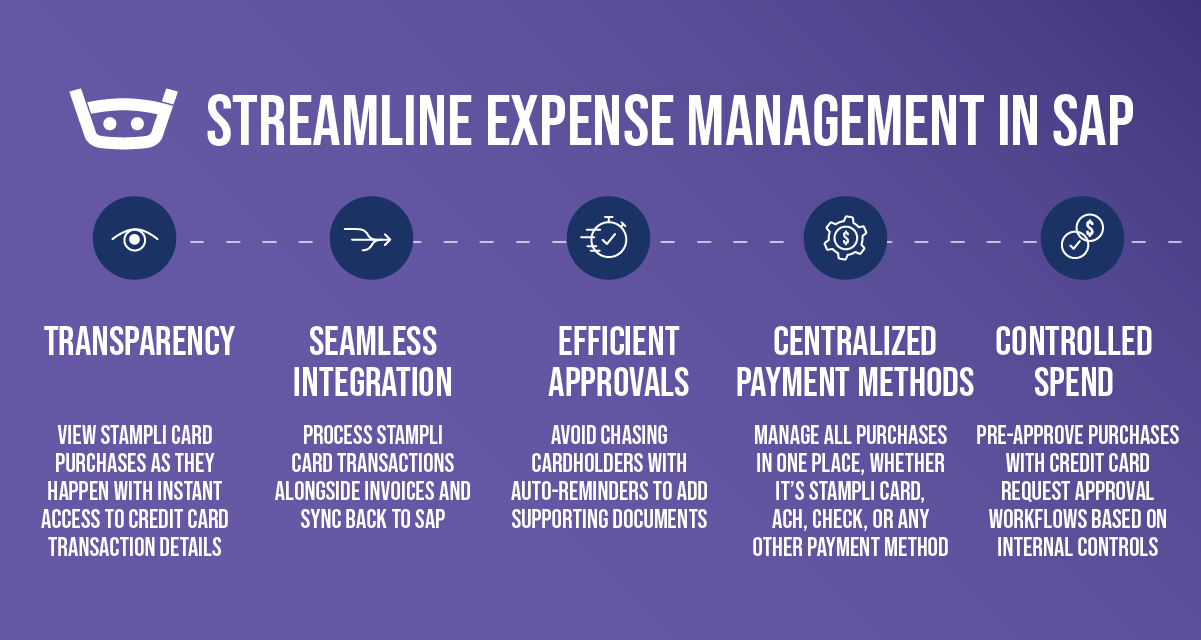
Optimize SAP accounts payable workflows with Stampli
Invoice processing time in SAP is known to be slow, but invoice processing time in Stampli is extremely fast. “Stampli has made a world of difference in processing time for our company. The ability to interface so easily with our existing ERP has made our process more efficient. The customer service provided by our team has also been exceptional!”
– G2 Reviewer
As the industry leader in accounts payable automation, Stampli provides a pre-built integration with SAP that streamlines AP workflows and provides a single source of truth for AP data across the organization.
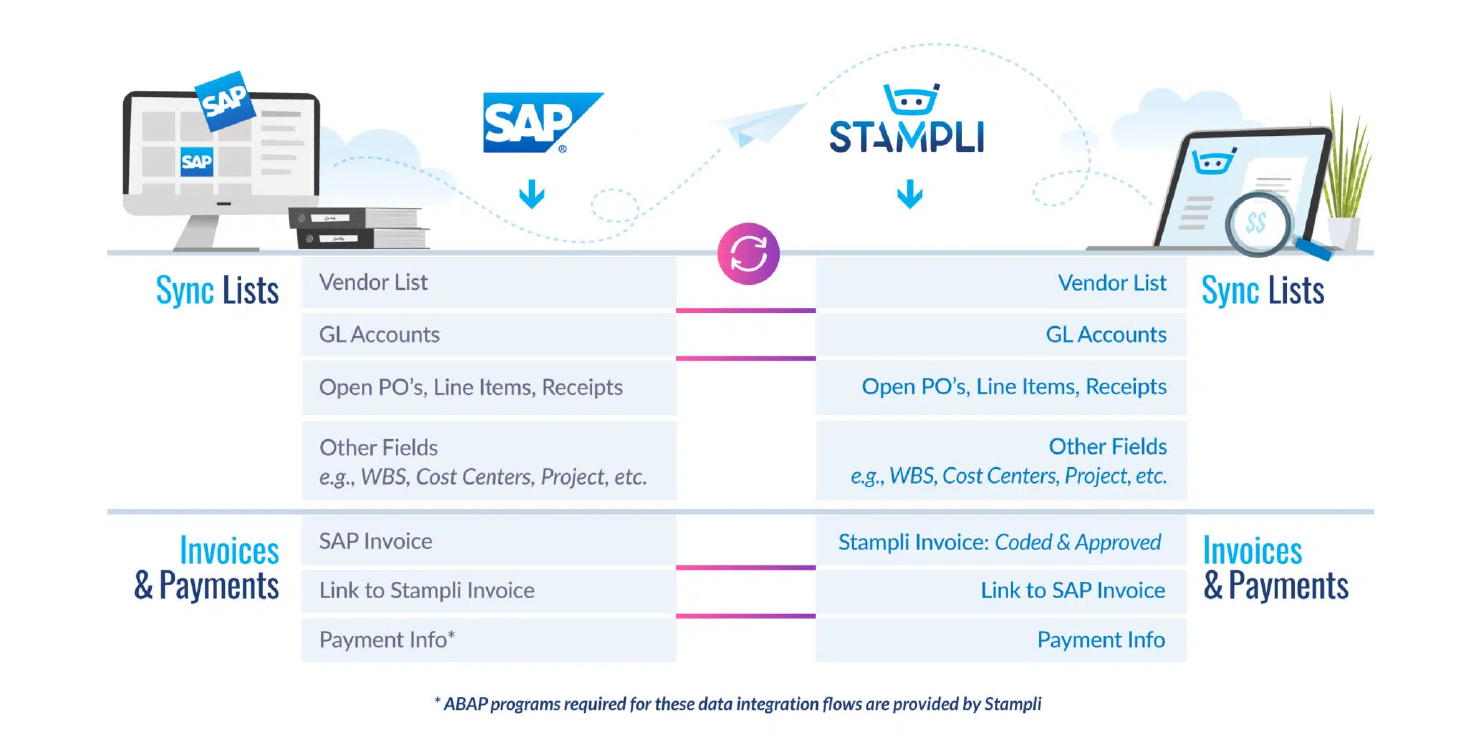
Seamless no-code SAP integration
You can set up most Stampli SAP integrations quickly and easily with minimal IT work or changes to your business processes. Stampli provides full support during implementation and uses your existing protocols to integrate the two systems.
With SAP, ERP customization often requires complex engineering projects. Stampli offers customization without complicated and costly development. “I specialize in improving processes and at times that includes implementing software solutions; with Stampli they were able to customize integration with our ERP system to allow us to track and better report…without any additional or duplicative work within the ERP system.”
– Aaron, Treasurer (Capterra review)
Streamlined AP processing
You can seamlessly share vital AP data like GL accounts, vendor lists, supplier information, departments, locations, and custom fields between Stampli and SAP modules to provide actionable, real-time transaction information to everyone in the AP workflow. Stampli frees your AP, Procurement, and Finance departments from overwhelming paperwork and miscommunication so they can focus on higher-value tasks.
Dynamic workflows
Some ERP systems require IT support or hiring consultants to update workflows when processes change. Stampli lets you opt for fixed workflows or leverage powerful AI-powered dynamic workflows to automatically learn your processes and adapt when they change — reducing dependency on extensive workflow customization projects.
The bottom line: Stampli is the smartest, fastest, and most flexible way to get the most out of your AP workflows with SAP. To learn more, book a free demo with us today.
